Pump Handbook by Igor J. Karassik, Joseph P. Messina, Paul Cooper, Charles C. Heald - 3rd edition
Подождите немного. Документ загружается.

9.416 CHAPTER NINE
inlet tip vapor vents and discharge hub vapor vents. Snorkel inlet pumps can receive
vapor handling assistance through the liquid ring reprime element. Any remaining air
and fuel vapor mixture is compressed as it passes through the increasing pressure within
the inducer and is redissolved into the fuel. Therefore, the pressurized fuel delivered to the
engine is free of vapor.
As the altitude increases, a tank pressure will be reached that will equal the vapor
pressure of the fuel. At this point, especially with wide cut fuels, the vapor release will
become quite violent (boiling). Here, the rate of vapor evolution will be determined by the
capacity of the tank vent system. As the light ends leave the fuel, the vapor pressure of the
fuel will decrease.This is referred to as “weathering” of the fuel. After the maximum cruise
altitude is reached, the vapor pressure of the fuel will reach equilibrium with the altitude
pressure.
The altitude climb test is the most difficult test to perform on airframe boost pumps
because it must be a single fuel pass test without recirculation to accurately reproduce an
actual climb condition. This requires approximately 1500 gallons (5,680 liters) of fuel for
one test on an average commercial airliner fuel boost pump element. Figure 5 presents the
results of an altitude climb test on the fuel boost pump depicted in Figures 3 and 4.
CONSTANT ALTITUDE PERFORMANCE__________________________________
This requirement for an airframe boost pump is specified in terms of a required fuel flow
range at a given temperature and at a constant altitude.The minimum required pressure
rise is also specified. The submergence of the inlet of the pump (for bottom mount types)
or the snorkel inlet (for snorkel inlet types) is also defined and is measured in the range
of a few inches. For altitude pressures lower than the initial fuel vapor pressure, the fuel
is weathered to achieve equilibrium with the altitude pressure. The fuel is recirculated in
this test. Figure 6 presents the constant altitude performance of the fuel boost pump
depicted in Figures 3 and 4.
GENERAL DISCUSSION OF ENGINE FUEL PUMPS ________________________
The primary fuel pump used for providing the boost and high-pressure fuel pumping func-
tion for an engine is called the “main fuel pump.” It is engine gearbox-mounted and driven.
In its most common form, it includes a positive displacement external spur gear high-
pressure stage and an integral centrifugal boost stage. This type of pump is exclusively
used on all modern commercial airliner engines and supplies all of the fuel flow require-
ments of the engine combustors. On commercial airliner engines, the main fuel pump is
the sole engine fuel pump and therefore is a prime reliability piece of equipment. All
engines, commercial and military, have a main fuel pump.
Positive displacement pumps have certain operating characteristics that make them
very adaptable to aircraft gas turbine engine fuel systems. These characteristics include
the ability to reprime from a completely dry condition and the ability to deliver useful fuel
pressure over a wide speed range. Engine control systems utilize a portion of the main
fuel pump discharge flow to power the actuation systems for fuel burn flow metering and
engine variable geometry control for all operating conditions. Corner point operating con-
ditions, such as altitude re-light and ground starting, occur at 8 to 10 percent of rated
operating speed. The pressure required for actuator muscle and response characteristics
at these conditions is generally a 250 lb/in
2
(17.2 bar) pressure rise. At the maximum
power take off condition at 100 percent speed, the pressure rise requirement ranges up to
1500 lb/in
2
(103 bar). Positive displacement pumps have proven capable of meeting these
needs and the external spur gear pump type has received the widest acceptance from the
industry.
The key attribute of the external spur gear main fuel pumps relates to the safety of
flight and prime reliability requirements. In over fifty years of experience, this type of
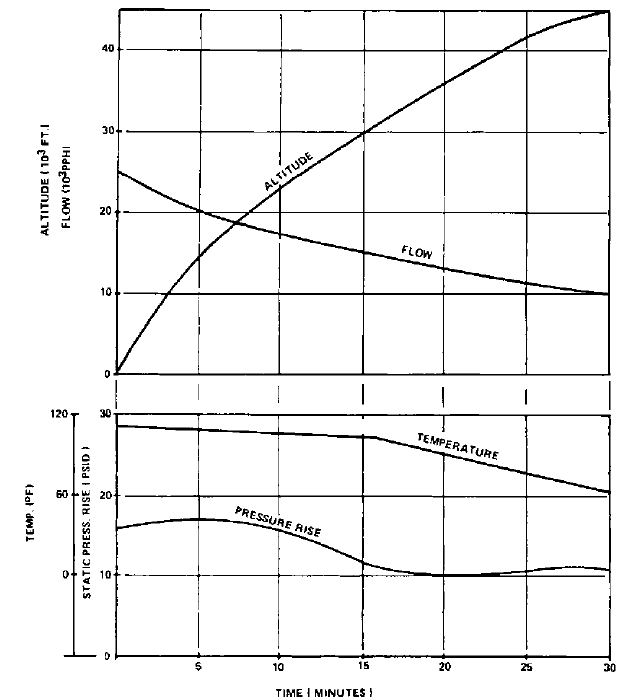
9.19.1 AIRCRAFT FUEL PUMPS 9.417
FIGURE 5 Main boost pump altitude climb (kg/h = PPH 0.4536; m = ft 0.3048; bar = psi 0.06895;
°C = (°F 32) 0.556).
pump has demonstrated a graceful type of failure mode. It does not fail in a catastrophic
manner in which it suddenly ceases to function. It slowly, over an extended period of time,
degrades in performance until it no longer meets minimum requirements, but continues
to function. In commercial service, these pumps routinely operate for over 10,000 flight
hours without service or repair.
Table 1 presents the pertinent characteristics of representative external spur gear
main fuel pumps.
Other types of positive displacement pumps, such as axial piston and sliding vane
pumps, have been applied to engine main fuel pumps. These have not achieved the level
of acceptance of external tooth gear pumps.
On highly specialized engines, such as military fighter aircraft engines, additional
high-pressure fuel pump functions may be required. These include fuel pumps for supply-
ing the thrust augmentation systems (afterburners) and, in some applications, fuel pres-
sure for the actuation system for the engine’s exhaust nozzle. Because augmentation fuel
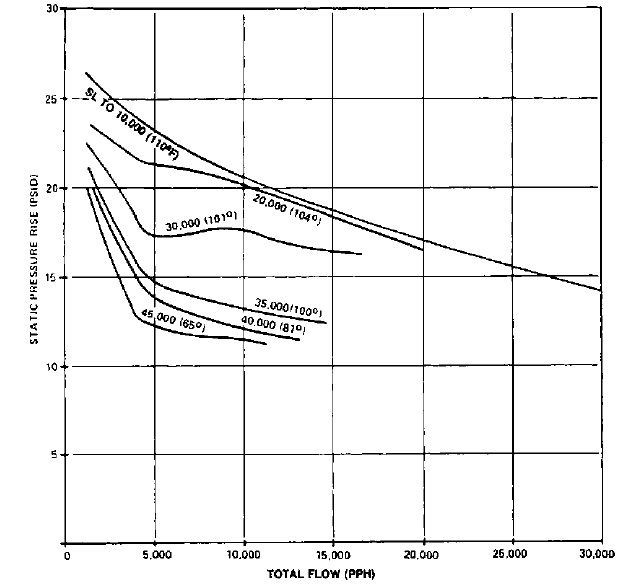
9.418 CHAPTER NINE
FIGURE 6 Main boost pump altitude performance (Altitudes are shown on the curves in ft; m = ft 0.3048; kg/h
= PPH 0.4536; bar = psi 0.06895; °C = (°F 32) 0.556).
flows are very high and the systems are operational for only a small percentage of the mis-
sion time, high-speed centrifugal pumps are used in these situations. Centrifugal pumps
offer a low unit weight and the ability to be run dry when the system is not operating,
thereby conserving power. These centrifugal pumps operate at speeds up to 25,000 rpm
and deliver up to 200 gpm (45.42 m
3
/h at 1000 lb/in
2
(69 bar) pressure rise. The fuel actu-
ation function has been provided by variable displacement piston pumps. The fuel boost
function for the multiple high-pressure fuel pump engines is usually provided by a single
centrifugal boost element either separately mounted on the gearbox or integrated with the
main fuel pump.
An alternative drive means has been used for the centrifugal augmentor fuel pump in
some applications. An air turbine utilizing engine compressor bleed has been used as a
drive source. When the system is non-operational, the pump may be stopped or idled by
throttling the turbine inlet air supply, thereby conserving power.
For large engines, such as those used on commercial airlines, the boost stage is a con-
ventional centrifugal element that generally incorporates an axial inducer. For smaller
engines used on general aviation and helicopter applications, various specialized cen-
trifugal elements and jet pumps have been used and have shown the capability of meet-
ing the needs of suction feed fuel systems.
As discussed the engine boost pump must function with the airframe boost pump in
both the operating and failed, or not operating, conditions. The engine fuel inlet pressure
with the airframe boost pumps operational is generally specified over a range from
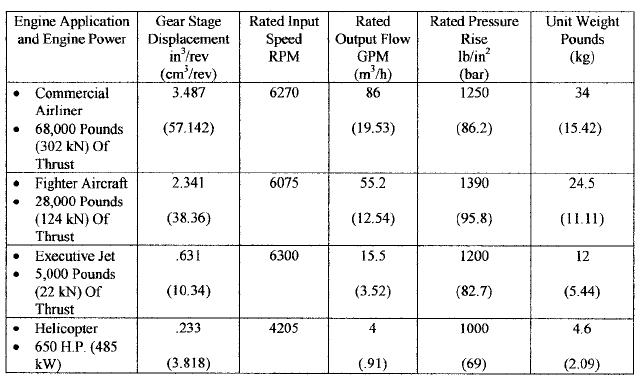
9.19.1 AIRCRAFT FUEL PUMPS 9.419
TABLE 1 Main fuel pump parameter chart
50 lb/in
2
(3.45 bar) to 5 lb/in
2
(.345 bar) plus TVP for all engine operating conditions.There
are to be no vapor or air bubbles present in the fuel. For the condition of failed, or non-
operating, air frame boost pumps, the engine boost pump is required to operate with an
inlet vapor-to-liquid volume ratio (V/L) of .45 at the maximum fuel tank temperature for
takeoff conditions to at least a 10,000 ft (3048m) altitude (to cover high altitude airports)
and appropriate V/L and fuel temperature conditions for maximum continuous thrust con-
ditions up to 45,000 ft (13,716m). The V/L condition occurs because of the line pressure
drop that occurs between the fuel tank and the engine boost pump inlet. This is depicted
in Figure 7. The value of the V/L ratio is defined as the volume of vapor divided by the vol-
ume of fuel. A V/L of .45 represents a void volume ratio of approximately 30 percent.
Because the engine mounted boost pump is line-mounted and is external to the air-
frame fuel tank, the vapor entrained by the fuel cannot be ejected back to the tank as it is
with the tank-mounted airframe pumps.All the vapor must be ingested by the boost pump
and be compressed and re-dissolved back into the fuel. If the boost stage becomes over-
whelmed by vapor, the vapor will build up at the pump inlet and the system will become
vapor locked. This must be absolutely avoided.
The value of .45 for the take-off V/L ratio has been established over the years as a value
that will provide adequate vapor lock margin. See Reference 2 for a history of the V/L para-
meter. Airframe systems are analyzed to ensure the margin is maintained. The reduced usage
of wide cut fuels in the future will somewhat relieve this requirement. Figure 8 presents the
relationship between V/L and tank altitude. Note that for a constant value of V/L, as the tank
altitude level increases, the pump inlet pressure, and therefore its NPSH, decreases.
In addition to the magnitude of the V/L ratio and the boost pump NPSH, the condition
of the multiphase flow is important. To ensure continuous and stable operation of the sys-
tem, the phases must be well mixed and have equal transport velocities.An operating limit
is reached when the phases separate and transport velocities of the vapor phases are less
than that of the liquid phase. Under these conditions, vapor will collect at a high point in
the system. In time, the system will become unstable if some means of removing this col-
lecting vapor is not provided. A rule of thumb for roughly estimating this transition point
is a minimum velocity of 3 ft/sec (1 m/s) for the liquid phase occupying the full diameter of
the pipe. For velocities below this level, the probability that phase separation will occur
increases. In practice, an adequate mixing of the phases is maintained in pump tests that
are run to prove the pump will meet the emergency conditions as previously defined.
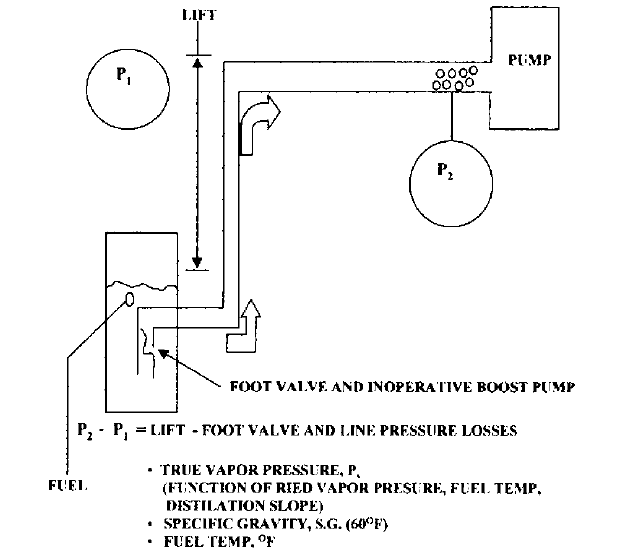
9.420 CHAPTER NINE
FIGURE 7 Factors that determine V/L ratio. V/L = O (P
1
P
2
)/(P
2
P
v
), where the Ostwald coefficient
O for typical fuels is in the range 0.1 to 0.2, depending upon these factors. Pressures P are absolute.
[°C = (°F 32) 0.556]
For the suction-feed fuel systems employed on some helicopters, the uniform mixing of
the vapor and liquid phases may not be maintained for all operating conditions. As previ-
ously discussed, these systems operate continuously under fuel-vapor-forming pump inlet
conditions for all engine operating conditions; that is, from flight idle to maximum contin-
gency power at all altitudes. Depending upon the engine fuel flow requirements, the fuel
temperature and type and the fuel line configuration, separation of the liquid and vapor
phases may occur. Because of the significant vertical pipe runs in these systems, this sep-
arated flow may exist in the form of alternating “slugs” of vapor and liquid flow in the line.
When flow conditions of this type occur at the inlet to the engine fuel boost pump, a
reserve volume of fuel must be provided within the pump. It is necessary to maintain a
continuous flow of liquid fuel to the engine combustors for the time period when the vapor
slug is being ingested by the pump and being compressed and redissolved into the fuel.
Figure 9 is a pictorial presentation of the potential vapor and liquid flow conditions at the
pump inlet. References 3 and 4 present a detailed review of these flow conditions.
DESCRIPTION OF THE DESIGN OF MAIN FUEL PUMPS ____________________
In this subsection, the design of a main fuel pump utilizing an external spur gear high-
pressure element for application on engines powering modern airliners will be discussed.
The designs of main fuel pumps for engines powering other classes of aircraft such as mil-
itary fighters, executive aircraft, and helicopters are similar and differ mainly in the

9.19.1 AIRCRAFT FUEL PUMPS 9.421
FIGURE 8 Vapor/liquid ratio versus inlet pressure (m = ft 0.3048; bar = psi 0.06895; °C = (°F 32) 0.556;
mm Hg = in Hg 25.4)
details of size and specific operating requirements. The flow and component schematic of
a typical commercial engine main fuel pump is presented by Figure 10. The components
encompassed by the dotted square are contained within the pump.As shown, the fuel from
the airframe system enters the boost stage inlet. It then passes through the engine oil-to-
fuel cooler where the fuel absorbs rejected engine heat, thereby fulfilling its function as a
heat sink. This positioning of the oil-to-fuel cooler also provides the de-icing function for
the next component in the system, the engine fuel filter. Using the engine oil-rejected heat
for the de-icing function eliminates the need for fuel heaters using engine compressor
bleed air as the heat source. These types of systems were used on previous generations of
engines incurring weight and engine efficiency penalties.
Fuel filters are usually rated at 10 microns nominal and 40 microns absolute.The min-
imum filter surface area is usually determined by the worst icing condition. A filter by-
pass valve is provided to ensure continuous engine fuel flow in the event the filter becomes
blocked. An indicator is provided to indicate impending filter bypass so maintenance
actions can be initiated.
The fuel then enters the high-pressure gear stage element and is delivered to the
engine fuel control unit at a pressure determined by the downstream resistance charac-
teristics. A high-pressure relief valve is utilized for burst protection for the high-pressure
components of the fuel system in the event of a downstream blockage.
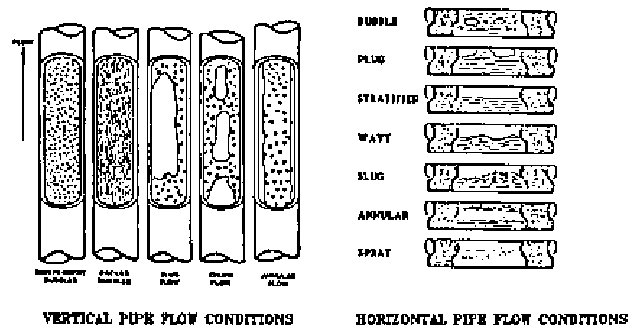
9.422 CHAPTER NINE
FIGURE 9 Possible multiphase flow conditions at pump inlet
The control of the engine fuel flow is achieved in the fuel control system by bypassing
the excess fuel back to the fuel pump upstream of the fuel oil cooler. This returned flow
represents waste heat that is proportional to the quantity of the bypassed flow and the
pressure differential between the gear stage and boost stage discharge pressures. This
waste heat further increases the gear stage fuel inlet temperature.
The volumetric flow characteristics of positive displacement pumps closely match the
fuel flow requirements of aircraft gas turbine engines. The ideal volumetric flow rate of
a positive displacement pump is directly proportional to its rotational input speed. In
actual practice, this is somewhat modified by the internal leakage flows that occur from
the high-pressure discharge to the low-pressure inlet. These leakage flows are a combi-
nation of flow through the clearances between the pump parts and the necessary bear-
ing lubrication and cooling flows. Also, leakage flows are proportional to the pressure
rise across the pump and essentially constant over the operating speed range of the
pump. Therefore, the leakage flows are a higher percentage of the ideal flow for lower
percentages of rated pump speed. The percentage of the ideal flow that the delivered
flow represents is the volumetric efficiency of the pump. Figure 11 depicts the basic rela-
tionship between the output characteristics of a positive displacement pump and the
engine fuel flow requirements.
As previously discussed, the main fuel pump is required to provide both the engine
burn flow requirements and the engine geometry actuation flow requirements. For a given
class and type of engine (for example, commercial airline turbo fan engines), the engine
geometry actuation flows are usually an essentially constant value for all engine speeds
for a given number of actuator servos.Therefore, because of the volumetric characteristics
of positive displacement pumps, the displacement sizing point of the high-pressure ele-
ment for larger engines will tend to be the rated take-off power high pump rotational
speed condition. For smaller engines, it will tend to be the starting low pump rotational
speed condition. The example in Figure 11 is sized at the starting condition. The disad-
vantage of this type of pump concept, clearly shown in Figure 11, is the significant over-
capacity of the high-pressure element for low engine power conditions such as the idle
condition. This over-capacity represents the quantity of waste heat in the form of throt-
tling loss in the bypass control loop that complicates the engine heat management system.
The task is to avoid reaching the fuel thermal stability temperature limit (about
325°F/163°C) in the combustor fuel nozzles. Exceeding this limit will result in clogging the
nozzles with fuel “coking” deposits. Significant effort has been expended on alleviating this
problem through the application of variable displacement pumps. These efforts have not
achieved general acceptance because of reliability, safety, and cost disadvantages.
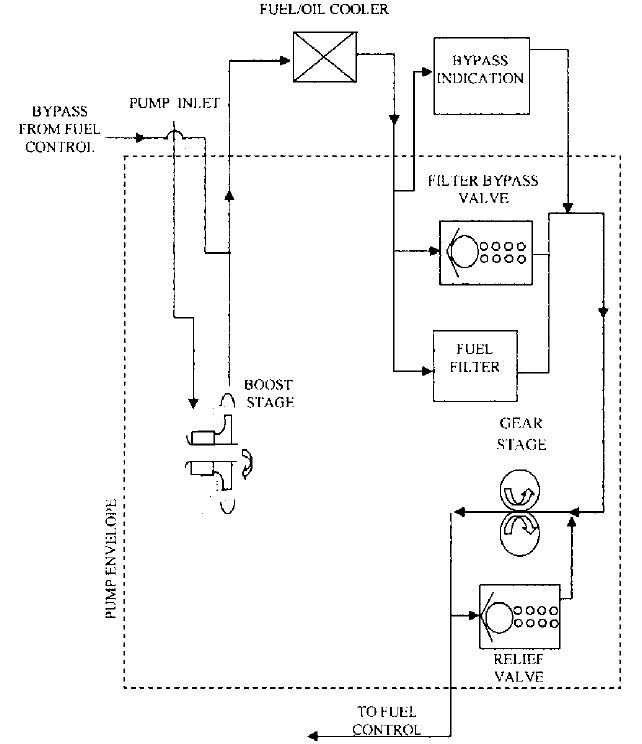
9.19.1 AIRCRAFT FUEL PUMPS 9.423
FIGURE 10 Main fuel pump system schematic
Figures 12 and 13 present a photograph and a cross-section of a main fuel pump incor-
porating an external spur gear high-pressure stage and centrifugal boost stage.The pump
is mounted directly to the engine gearbox and the rotational input power is transmitted
directly to the spur gear stage by a spline coupling. The boost stage is driven by a sec-
ondary splined coupling. The drive priority is selected to reflect the power input order of
the elements and that the high-pressure element is the primary pumping element. The
housings are aluminum castings that provide the minimum weight and also provide the
necessary structural integrity and stiffness for all specified conditions.
A face-type dynamic mechanical shaft seal is provided at the drive end of the pump. A
wide range of design configurations have been employed, but all modern pumps utilize the
sealing faces as the primary seal and “O” rings for the secondary seal. These seals are
required to operate with pressure differentials in both directions. Special design features
must be employed to accommodate this requirement. The drive shaft seal is vented to a
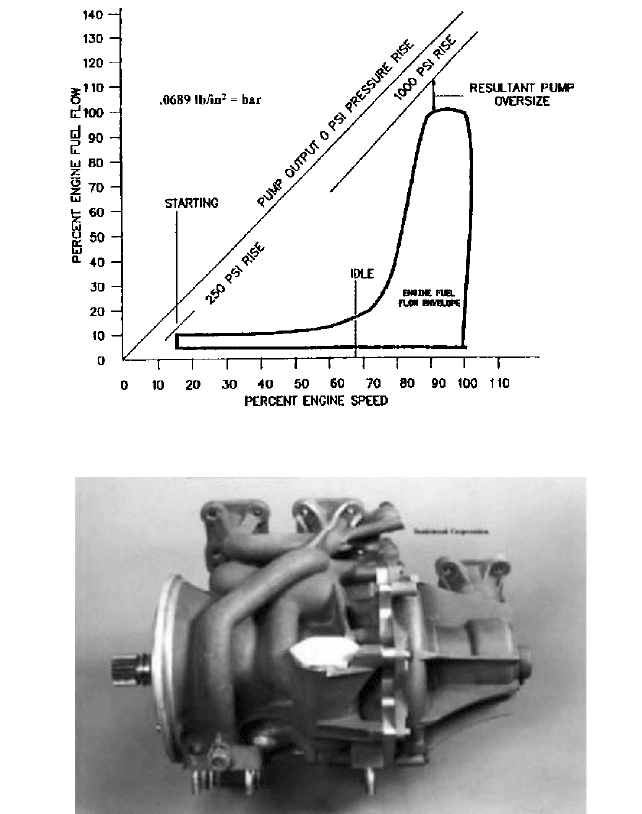
9.424 CHAPTER NINE
FIGURE 12 Main fuel pump assembly (Courtesy Hamilton Sundstrand)
FIGURE 11 Positive displacement pump output characteristic versus engine flow requirements
dry cavity that is connected to the engine overboard drain system. For reasons of safety, all
fuel and oil passages separated by seals, static or dynamic, must have double seals with a
drain port between them.
The type of external spur gear pump element used in main fuel pumps is the fully
pressure-loaded type. Figure 14 depicts the basic details of the configuration used. The six
parts shown in Figure 14 are assembled into a figure-eight bore arrangement in the pump
housing. The four bearing blocks, which are a slip fit, are pressure-loaded towards the
faces of the spur gears, and the assembly as a whole is pressure-loaded towards the inlet
side of the housing bores. An initial axial sealing force is provided by springs. The axial
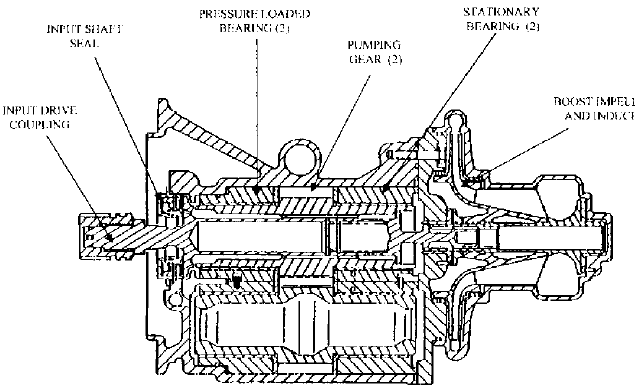
9.19.1 AIRCRAFT FUEL PUMPS 9.425
FIGURE 13 Main engine fuel pump cross section (Courtesy Hamilton Sundstrand)
pressure blow-off and pressure loading forces are closely balanced. This provides a
pressure-balanced seal between the end faces of the spur gears and the bearings. This
minimizes leakage over a wide range of delivery pressures on low viscosity jet fuels. The
overall arrangement provides the necessary flexibility to maintain the minimum possible
leakage clearances between the discharge and inlet over the complete range of operating
conditions for many thousands of hours of operating life. The inherent flexibility of the
design provides it with the unique capability of automatically compensating for the dif-
fering rates of thermal expansion of the materials used in the construction of the pump
and the wear that will inevitably occur in usage.
The gears are manufactured from highly alloyed tool steels and surface hardened to
resist wear in the harsh environment of low viscosity and low lubricity aircraft gas turbine
fuels.The gear profile, lead error, and tooth spacing are held to very low limits. The round-
ness of the gear journals is also held to a very close limit and a mirror-like finish is applied.
These journal dimensional characteristics are required because of the very low film thick-
ness (6 to 30 micro inches or 0.15 to 0.76 microns) encountered. This is attributed to the
low viscosity of hot aircraft gas turbine fuel (1 to .5 centipoise). The bearing surfaces,
radial and thrust, are a highly leaded bearing bronze alloy generally with a solid film
lubricant coating to assist in the initial “bedding” in.
The bearings are designed to provide full film lubrication for all operating conditions
with the exception of the starting condition. On some pumps, a hybrid bearing design that
incorporates a high-pressure pad to augment the bearings load carrying capacity is used.
The bearing thrust faces contain gear trapping relief cuts that control the gear mesh flow
dynamics.This includes avoiding any fluid trapping conditions, controlling gear stage inlet
and discharge pressure pulsations. Figure 15 is a photograph of a gear set with two of the
bearings.
The design of the centrifugal boost stage is quite similar to that used for the airframe
boost elements.The inlet must be sized to handle the total inlet flow rate consisting of the
vapor phase and the liquid phase. The use of axial inducers has become common on all
sizes of pumps because of the severity of the required inlet conditions. The selected over-
all pressure rise of the boost stage is primarily dependent upon the temperature and,
therefore, vapor pressure of the fuel at the entrance to the high-pressure element and the
various pressure losses between the boost stage discharge and the high-pressure element
